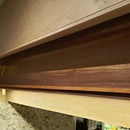Introduction: DIY and Better Festool Rail Connectors
So, have you purchased a Festool track saw and another track to try and save $200 over buying the longest rail? You probably also purchased the Festool rail connectors and expected them to work as advertised. Sure, align the rails and set the screws then make your cuts. Sounds simple, and everyone at woodcraft will tell you it works great. But that's not the case for you, so that's why you are curious about this instructable.
The main problem I have with the connectors, besides the $36 you shell out for them, is the set screws. If you do not tighten them enough, the track will not stay straight after moving. If you tighten them too much, then you will create indentations in the rail and the screws will not hold well over time. After finding a post on the Festool owners group site, reading through the posts on there and determining all the parts needed and what to do with them, I decided to create this tutorial so that no-one will have to do the same.
The design of these connectors is very simplistic and amazingly effective. Instead of worrying about destroying your rail by over tightening the set screws and having to check for alignment constantly, you can tighten these as much as you want without that problem.
You will need to get a few things to accomplish this build:
From Mcmaster carr
Low carbon steel 4mm x 12mm x 3' 6775T43 $5.84
Low Carbon steel 2mm x 12mm x 3' 6775T23 $4.69
From anywhere you can find them:
4 - #8x32x1/4 machine screws.
8 - #10x32x1/4 set screws
1 - #8 tap
1 - #29 drill bit
1 - #10 tap
1 - #21 or 5/32" drill bit
Cutting oil
Drill Press
Clamps or carpet tape
Hacksaw
Grinder or file to clean up the edges
Step 1: A Possible Alternative to the 18 Inch Versions
I made my pair 18 inches long. i am considering a much larger pair in the future. The one thing about the Festool rails is that they are flimsy without support underneath. The 18 inch version helps to create a more stable rail, but if you could make a set the length of the entire rail it would be much more stable. And you could possibly make or purchase the ezsmart bridge and then modify it for the Festool rails.
Step 2: Gather Your Materials
Since the idea of this is to use the set screws to separate the thinner piece away from thicker, you will have two different hole patterns on the metal. I have attached the PDF of the dimensions for better viewing, but have also exported an image for viewing in this tutorial.
- Measure to 18 inches on each metal bar stock
- Cut the bars at the 18 inch marking
- You may have edges on the end that are not clean enough to do the next step. Clean up the edges so that the metal pieces can lay flat against each other. This will help in the machining process later.
- Clean the metal off with a degreaser or alcohol and attach the two similar pieces together with the tape or the clamps.
- Clamp the thinner sets in a way that you can align and properly drill your holes. I used a cross slide vise so that I could align the drill bit to the center and then move the material for each hole. This way I know they are aligned.
- Mark the center at 9 inches so that you have visual reference to align your rails and now have a mark for measuring off of for your set screw holes.
- Remember to use cutting oil with all of the drilling and the tapping. There are plenty of tutorials on how to drill and tap metals. I will not go in to that.
- The thicker set will be getting the most holes tapped, and you will use both drill bits on this set. First drill the four holes for the set screws. These are the #21 or 5/32" drill bits. The locations are identified in the PDF, but they are 1 inch from the ends and 1.5 inches from the center line.
- Remove the drill bit and replace with the #29 drill bit for the machine screws that hold the pieces together for storage.
- Drill the next two holes at 4.5 inches from the center line on both sides.
Now that your holes are drilled in the first set of bars, align the first thicker bar to the thinner bars. Then use a center punch to mark the location of the drill holes for the #8 machine screws.
- Drill the #8 machine screw holes using the #29 drill bit.
- Now move on to tapping and inserting the fasteners.
Attachments
Step 3: Tapping, Inserting Fasteners and Connecting the Guiderails
I am not going to go over how to tap the holes. Here is a link to an instructable someone else made that will show you how to do it.
- Separate the two thinner bars.
- Now that you know how to tap, use your #8 tap to tap the 8 holes for the machine screws.
- Use your #10 tap to tap the 8 holes for the set screws.
- Lubricate your machine and set screws.
- Clamp the two different pieces together when aligned and put the clamps close to the holes. This will make sure that you can insert the machine screws without the pieces separating. Then once you get the screw all of the way through, back it out and in a few times so that when the screw is all of the way in the pieces are completely together without a gap.
- Insert the set screws as far as you can and back them out to where the pieces do not have a gap.
- Repeat on the other set.
Now that your connectors are built, it is time to test them.
- Insert the connectors in the bottom and the top tee tracks until the marking line aligns to the edge of the first rail. Now you can loosen the machine screw to allow for a larger gap when the set screws are tightened.
- Tighten the first four set screws so that the connectors cannot move.
- Attach the second rail to the connectors and slide in until they meet. A little gap of maybe .5mm for movement while connecting is ok.
- You can use a 6 or 8 foot level for this step. Also, woodpecker sells a very nice straight edge that would work if you have that in your shop. Place the straight edge against the back edge of the rail and pull the two rails in to alignment until there is as little of a gap as you can get in between the straight edge and the rails.
- Tighten down the top side set screws and check for a gap. repeat if necessary.
- Flip the rail over and do the same thing again.
- Check again for alignment. It should be as it was in the previous step. But now, you can test how well these hold.
Now that they are together, they are very rigid. I haven't been able to get them out of alignment, at least at this point it is not noticeable after many cuts and use if there is an issue with the alignment.
One note on my build, the design I saw had the machine screws in the bottom. This meant that you could not tighten the stock together until you removed the bars. I wanted to be able to access everything from the top when inserted.
Another thing, you may have issues trying to find the #8 machine screws in 1/4 inch length. I did. no big box store in my area carries them. So I used 1/2 inch length and once I had them fully inserted, I used the hacksaw to cut off the rest and filed it smooth.










